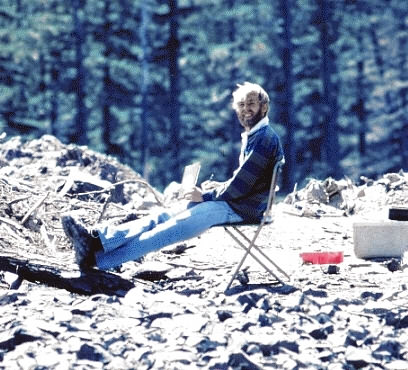|
 David Johnston, 30-year-old volcanologist with the U.S. Geological
Survey,
was swept away by the catastrophic eruption of Mount St. Helens on the morning
of May 18, 1980. As one of the first members of the U.S.Geological Survey
monitoring team to arrive at Mount St. Helens and the scientist in charge of
volcanic-gas studies, Dave spent long hours working on and close to the
mountain. Ironically, he was caught at an observation post that was considered
relatively safe. From his experience with active Alaskan volcanoes, Dave
understood better than most the hazards of explosive volcanism. At the same
time, he repeatedly voiced the conviction that adequate hazard assessments
require accepting the dangers of on-site monitoring of active volcanic
processes. The volcano-monitoring effort of which Dave was part helped persuade
the authorities first to limit access to the area around the volcano, and then
to resist heavy pressure to reopen it, thereby holding the May 18 death toll to
a few tens instead of thousands.
David Johnston, 30-year-old volcanologist with the U.S. Geological
Survey,
was swept away by the catastrophic eruption of Mount St. Helens on the morning
of May 18, 1980. As one of the first members of the U.S.Geological Survey
monitoring team to arrive at Mount St. Helens and the scientist in charge of
volcanic-gas studies, Dave spent long hours working on and close to the
mountain. Ironically, he was caught at an observation post that was considered
relatively safe. From his experience with active Alaskan volcanoes, Dave
understood better than most the hazards of explosive volcanism. At the same
time, he repeatedly voiced the conviction that adequate hazard assessments
require accepting the dangers of on-site monitoring of active volcanic
processes. The volcano-monitoring effort of which Dave was part helped persuade
the authorities first to limit access to the area around the volcano, and then
to resist heavy pressure to reopen it, thereby holding the May 18 death toll to
a few tens instead of thousands.
Born and raised in Illinois, Dave Johnston was graduated in 1971 from the
University of Illinois, Urbana, with "Highest Honors and Distinction" in
geology. His strong interest in volcanism began with his first geologic project
studying Precambrian volcanic rocks in the Upper Peninsula of Michigan. This
interest in volcanic phenomena intensified with subsequent work in the San Juan
volcanic field of southwestern Colorado and on Augustine Volcano in lower Cook
Inlet, Alaska. The Augustine study was the basis for his doctoral dissertation,
completed in 1978 at the University of Washington, Seattle.
Following his Ph.D., Dave increasingly focused on the fundamental role of
volatiles in volcanic processes, as he continued his studies on Augustine and
began work on Katmai Volcano, Alaska. His work on volcanic gases brought him in
1978 to the U.S.Geological Survey, where he was assigned to expand the program
for monitoring volcanic emissions in Alaska and the Cascade Range. A specific
objective of such monitoring is to test whether or not changes in gas
geochemistry might provide precursory clues of impending eruptive activity.
Thus, it was natural that, when Mount St. Helens reawakened in march 1980, Dave
Johnston was one of the first geologists on the volcano.
Dave Johnston was an exemplary scientist, and his approach to his work was a
model for all: dedicated and hardworking, with meticulous organization and
observation followed by careful evaluation and interpretation. At the same
time, Dave was unaffectedly genuine, with an infectious curiosity and enthusiasm.
But perhaps his most essential quality was the ability to dissipate cynicism; he
looked for, saw, and thereby encouraged the best in all of us. Dave would have
expected us to carry on without him, learning all we could from the Mount St.
Helens catastrophe.
-- From:
Lipman and Mullineaux (eds.), 1982,
The 1980 Eruptions of Mount St. Helens, Washington:
USGS Professional Paper 1250, Dedication
|